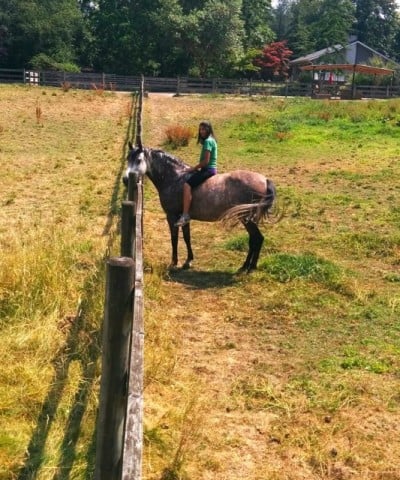
You may have heard of equine permaculture systems and yes, most of the information and sites are based in Australia. Which is not too helpful for those of us in rainy climates like the Pacific Northwest or UK!
However, you may also have noticed that in the places in Australia that get heavy seasonal rains, they need to lay a road base on any of the walking paths that connect to the central paddock area.
This is the same challenge we face when designing Paddock Paradise walking tracks. I’ve already written a very detailed post about what’s involved with creating mud-free drainage surfaces in this climate, so I won’t repeat that here – maybe stop reading here and go check that out first…
Equine Permaculture Design for Rainy Climates
Okay, so what can we do in our rainy, temperate climates that helps us to:
- Preserve our fields, soil, and plant life
- Minimize worm burden and infestation
- Enable our horses to have grass to eat during the summer months
- Make feeding, watering and caring for our horses efficient and not too labor intensive
My solution to these challenges is to have enough fields (at least two fields for every 1-2 horses) so that you can keep flipping them.
I designate one field as a sacrifice field and this needs to be the field that my horses live on from Sept/Oct (depending on when the rains start) through to May/June (or whenever the rains subside). I know that they will absolutely trash this field, destroy much of the plant life root system, and turn much of it to bare mud:
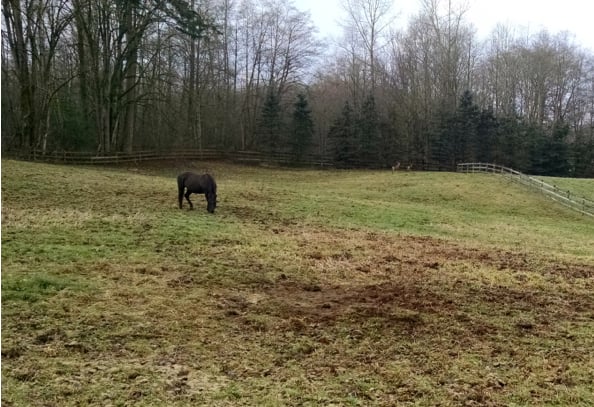
However, this field, unlike the Aussie systems, is always open to my dry paddock area; with plenty of slow feeders under shelter and a proper drainage surface to keep their hooves dry and thrush-free through even the worst of rains:
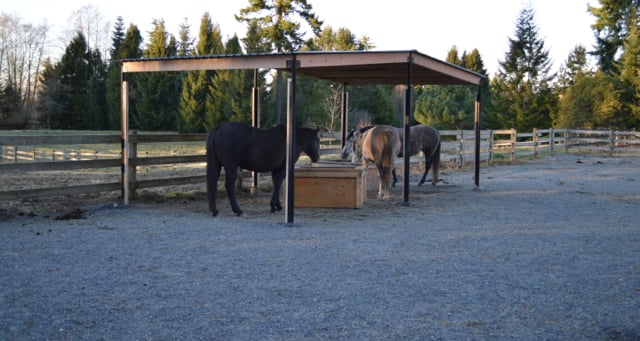
I even had a horse stay with me who typically went lame every winter and she stayed in good shape with no thrush infection the entire spring/winter/fall because her hooves stayed dry enough and the mixture of gravel on the paddock surface helped to strengthen her hooves (3/4″ minus gravel with crusher dust on top).
The key to keeping this central paddock surface in good shape is to daily remove every bit of organic matter from the surface of your gravel/crusher dust – manure, leaves, hay, etc. Otherwise, it will build up and create a new layer of wet “soil” on top of your dry surface.
My horses roam freely from this dry gravel area – which is big enough for them to move around, lay down, play, etc. – out into the sacrifice field all winter long. For example, if you have 2 horses in a 2 acre sacrifice field, they will have some grass to nibble throughout the winter; it will not turn completely to mud – as long as you also have the dry paddock area with free choice hay in slow feeders.
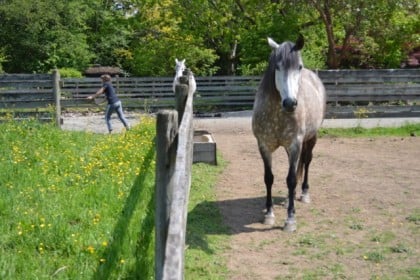
Then, in the spring/summer – once the ground has hardened up enough to lock-in the vegetation root system – I let them onto the reserve field. Now keep in mind, this 2nd field has been sitting untouched through the entire fall/winter/spring so the grass is quite tall.
If they go into the 2nd field during the Spring growing season, then I start them out with only 15-30 minutes per day and gradually ramp up as their bellies grow accustomed to the rich grass. If you needed to keep sugar levels really low (due to diabetes, laminitis, etc.), then you would do a very gradual re-introduction to grass.
How To Have Enough Grass for the Entire Summer
So now your horses are in the 2nd field, munching happily away on grass… until that grass runs out – which it will, unless you have about 10 acres per horse, divided up into separate fields.
And here’s the really important part that a lot of people don’t consider: Your horse will not eat where he poops. This is the equine’s first line of defense against a heavy worm burden, so you do not want to interfere with it by forcing them to eat worm egg-infested grass!
So even though it may look like your horse still has plenty of grass to eat in the field, when you go out and walk that field, you’ll see that due to the manure burden, it’s actually pretty much finished.
Well this is where having a 3rd field comes in handy. So now you turn your horses out into your 3rd field and you hire some local teenagers to come in and clear your 2nd field of all the manure in it. I find that 3 teenagers can clear 2 acres in about 4 hours. I pay them $10/hour and get the entire field cleared in one day for only $120!
Then that field can sit and bake a bit in the sun, and the grass can re-grow, while the horses eat in the 3rd field. Remember that short grass has higher sugar levels then longer grass (6 inches is ideal for low sugar and also to preserve the root system). So if your horse has any sugar issues (laminitis, founder, diabetes, etc) you’ll want to keep them off the pasture until the grass is longer. You might also want to let them graze in the early morning hours only (5 am – 10 am), but, this is not always accurate as weather conditions like drought, frost, etc. can greatly affect grass sugar levels.
Again, your 3rd field also hubs off of your central paddock area. As in some of the Australian equine permaculture systems, you may want to keep your horses restricted to the central paddock area overnight. In that case, you would make sure you have slow feeders in there filled with low-sugar hay. Remember, equine guts produce stomach acid 24/7! They do not shut down during the night, so it’s not okay to only have hay or grass available during daylight hours.
For myself, my horses always have access to the central paddock area – from whichever field they’re in – which also provides shade for them under the shelters on hot days. I also keep their water buckets in the central paddock, which is closest to the barn and water faucet for easy filling.
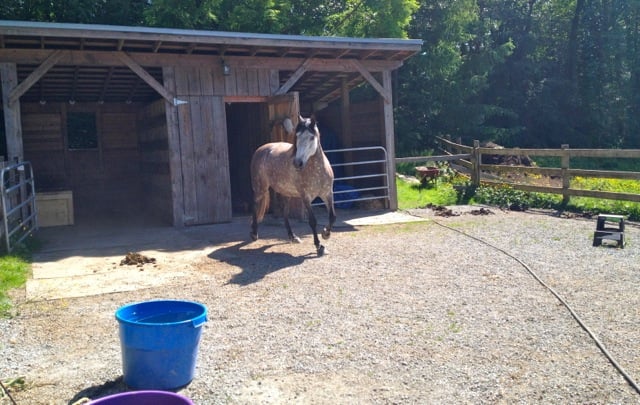
By the time they have eaten down the 3rd field, the 2nd field is ready to go again. And then you clear the manure from the 3rd field and allow that to rejuvenate, and so on.
Of course, the more fields you have, the easier the process gets, and the lower the worm burden in each field. Due to increasing parasite resistance to chemical wormers, using this sustainable approach to worm management becomes very important, and well worth the effort.
And what’s happening during this time with the 1st, sacrifice field, you might wonder? Well, you’ve closed it off for the remainder of the year (until next Spring/Summer), you’ve removed the manure, and you’ve re-seeded it with a good grass blend. However, don’t plow it unless you can irrigate in the Spring if needed, and then leave the field empty until you have mowed the first growth of grass. This establishes a strong root system before turning the horses out on it again.
Here’s an example of what a 3-Field Equine Permaculture set-up can look like. The triangles are gates; so you can see how each field can be opened to the central dry paddock area and the other fields closed off as needed:
As I mentioned, since your slow feeders and water buckets/trough are also located in this dry paddock area, feeding and watering in all seasons is efficient and doesn’t take very long. You are also close to the electricity supply in the barn in case you need to add a line of electric fence, or heat the water buckets in winter.
This kind of a system also works really well for introducing new horses to your herd, as you can do it gradually and let them work out their relationships over the fence. It also makes it easy to move the horses around and to take them out for rides or walks.
Some people have a large barn with multiple stalls, so their horses can come into their own stall in the evening for their vitamin/mineral feed. Some keep their horses in overnight, others let them wander out when they are finished their feed. As long as your horses like it and have access to hay in slow feeders and water all night, either way is fine.
What If I Only Have 2 Fields?
Now, let’s say you only have 2 fields total, plus your dry paddock area. In that case, you still designate one field as your sacrifice field. But when they have eaten down your 2nd field in the Summer, you put them back into the sacrifice field to nibble a bit and you keep their slow feeders filled with low-sugar hay in the central paddock, so they have enough food while the 2nd field is re-growing. In the Fall, you close off the sacrifice field to let it rejuvenate (remove manure and re-seed it) and the horses spend the wet Fall, Winter and Spring in your 2nd field (which is now becoming your new sacrifice field!) and dry paddock.
You continue on like this, repeating the process every rainy season (Fall/Winter/Spring). And of course, you keep removing manure from both fields as you go.
The reason we have to remove manure in temperate or rainy climates is that the winters don’t get cold enough and the summers don’t get hot enough to kill the worm eggs. For example, roundworm eggs (parascaris equorum) require 17 hours at 113 degrees Fahrenheit (45C) to die. That’s why you should not spread manure on your fields, or harrow the manure, unless you have composted it first! Unless of course, you live in Texas or Arizona or Mexico where your manure can bake in the sun for a few weeks before and after harrowing.
The science isn’t clear yet on how cold temperatures have to get and for how long to kill worm eggs. We do know that 7 days at -20 degrees Celsius does not kill the eggs, but there are no experiments I’m aware of that track 30-60 days of exposure at -20 to -40 degrees Celsius. So the best method is still manure removal and composting.
Of course, if each of your 2 fields is 100 acres each, then you probably don’t need to worry about manure removal… unless you have 20 horses on those fields! Basically, you have to walk your fields and do a visual inspection as to how much of your field does not have manure piles on it – because those are the only areas they can eat from.
Plowing & Re-Seeding
By July, you will need to completely close off your sacrifice field to allow it time to rejuvenate for the rest of the summer and winter, and remove all manure. Ideally, you should re-seed it at this time with a good grass blend and an inch layer of composted soil if you can – but don’t plow it unless you can irrigate in the Spring, if needed, and then leave the field empty until you have mowed the first growth of grass.
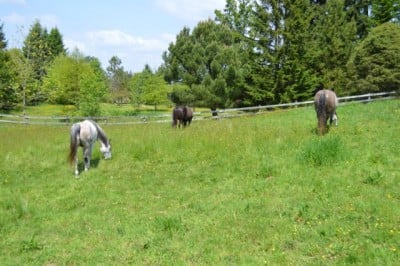
A farmer friend told me that when you plow and re-seed a field, you have to allow the root system to get strong enough, before you put the horses back on there. So the way to do that is to let the first growth of grass grow up at least 6 inches. Although you can put the horses on the field at that point, it is best if you can mow it, then let the grass grow up again to 6 inches high, and then you put the horses on it. This method also helps keep the sugar levels in the grass down.
That’s why it’s easier (especially if you only have 2 fields) to just sprinkle some good grass seed on there – add an inch of composted soil on top if possible – and then close it up until the next late Spring or Summer. Remember, you have to let the ground harden before you turn the horses out on it, so don’t put them out too early.
What If I My Fields Aren’t Big Enough or Cross-Fenced?
For my set-up right now, I have 3 fields, but they are not big enough to provide my four horses with enough grass to exclusively graze through the summer.
So I still do the field rotation and manure removal as described above, but I also keep their slow feeders in the central paddock filled 24/7 with low-sugar hay, all year round. Some days they hardly eat any hay, and other days they eat quite a bit.
I will soon be moving my herd to 27 acres at a friend’s place. However, it is not cross-fenced at all and a good portion of it is treed, or has a spread of inedible plants like buttercup. So I am setting up a covered area with slow feeders, but I am not going to put any hay out for them until I see that they are running out of forage.
I figure if I put hay out right away, they will not bother to forage much for food! And interestingly, horses are not grazers; like cows or sheep. They are foragers who selectively eat some plants and not others. Equine ethologist Lucy Rees has noticed in her observations of wild herds that wild horses eat a much wider variety of plants and foliage than domestic horses, including acorns. Since 3 members of my herd were semi-feral, it will be interesting to see if they teach my domestic horse how to forage more effectively.
So I will keep an eye on their weight and behaviour and when it looks like they need supplemental feeding, then rather than keeping their slow feeders filled 24/7, I’m going to experiment with putting out the amount of hay needed to sustain their body weight.
Sources say a horse needs 15-20 lbs of hay per day. But I’ve found mine eat closer to 40 lbs per day when exclusively fed free-choice, low-sugar hay in slow feeders and this keeps them at a good weight and healthy. Keep in mind though, that my horses are all big: Belgian, Andalusian, Belgian/Fjord and Belgian/Arab.
So I may start them at 20 lbs each per day, since they will also have plenty of land to go out and forage if they want to keep eating. And I’ll see how they do with that. If I see that it’s not working well, physically OR emotionally, I’ll go back to keeping their slow feeders filled 24/7 and letting them choose when/where they eat!
I think it’s important to give ourselves permission to experiment. And to acknowledge that as we seek to provide the best care for our equines, that we are always on a learning curve. And above all, to listen to our horses! We can have all kinds of ideas or theories, but our horses will tell us what they need if we are open to listening.
How Much Land is Enough To Sustain a Horse Easily?
In case you’re wondering exactly how much land you need to have to be able to not have to manage your pastures… The best information I’ve come across is, again, from equine ethologist Lucy Rees, who currently has 33 wild horses in a dry, rocky, mountainous region in Spain on 1300 hectares (3212 acres). As they are natural, wild horses, they are in family groups of 8-10, each with a stallion. And she has to cull to prevent population overgrowth, which would result in starvation. So using her numbers… to be self-sustaining and able to forage for their own food year-round, her horses in their sparse, rocky, mountainous terrain, need roughly 100 acres per 1 horse.
Now, if you had non-stop prairie grassland, I think you would need less acreage than that. In Alberta I kept 3 horses on two fields of 8 acres total eating only grass all Summer and Fall until the snows started. Then they needed to be hay fed through the Winter and early Spring.
In Isabella Tree’s amazing book, Wilding, she reports that her wild ponies in the lush, rainy UK require 8 acres per horse to be completely self-sustaining, year-round. Her bison require 22 acres each.
Here in the Pacific Northwest of BC, 2 horses require at least 5 acres of pasture divided into 2 fields to be able to eat grass during the summer months. And again, in the Spring, Fall, and Winter, you need to feed hay.
The really interesting thing about Lucy Rees’ herd is that they fare better in Winter, than Summer. They grow thin in the dry Summer months and then fatten up in Winter when it snows and acorns fall (which they eat).
Medicinal & Other Edible Plants
As foragers, horses should ideally eat 25-30 different plants per day. If your current pasture or permaculture system cannot provide this diversity, you still have a number of options that will work well to provide your horses with adequate forage plants for both nutritional and medicinal purposes… (yes, the blue text is a hyperlink – click it!)
Whew! Is that enough information to take in? As per usual, any questions or thoughts – please share them below… 🙂

Jini Patel Thompson is a natural health writer and Lazer Tapping instructor. She began riding at age 2 in Kenya, and got her first horse at age 8 in Alberta, and so continues a life-long journey and love affair with these amazing creatures.


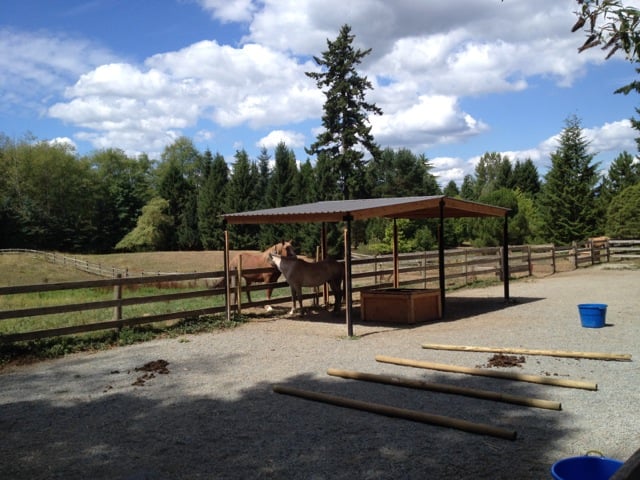

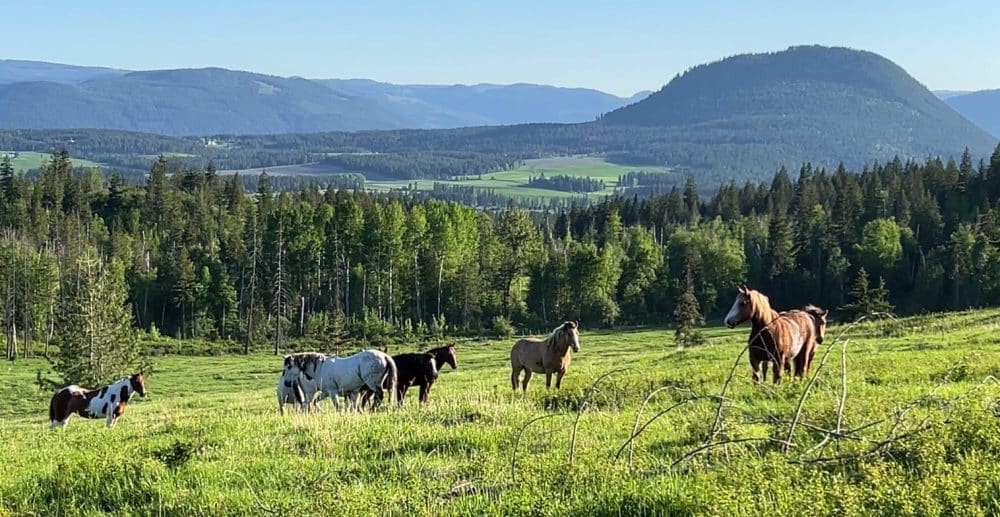







One more thing: A paddock paradise, or walking track system is more challenging in a wet, muddy climate. But even if you just install a walking track around the perimeter of your property and combine it with the equine permaculture system above – your horses will be very happy. Here are some great resources on Facebook, the first one is in the UK so has lots more ideas for our rainy climate:
https://www.facebook.com/groups/808480805889892/
https://www.facebook.com/OfficialPaddockParadisePage/
I’m not a horse owner but I Absolutely love this article combining two of my passions. First thing I’ve read about Equine Permaculture but hope that our current situation means that this becomes more well known in coming years. Thanks Jini
Have you read the book, Wilding, by Isabella Tree? THAT book rocked my world – that’s what I’m aiming for now!